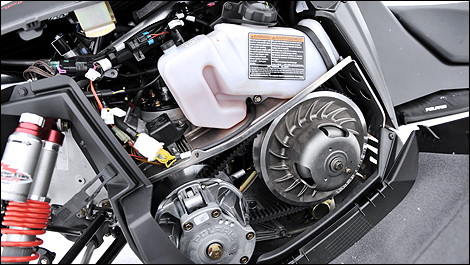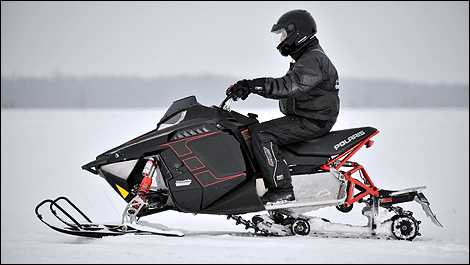The Rush calls on the excellent P2 CVT tranny as on most Polaris models. The ultra-efficient P2 contributes to great throttle response, while the RipSaw track with 1.25-inch spikes helps the machine claw through the worse trail conditions.
 |
| The new 600 Rush is powered by the latest evolution of their twin-cylinder Cleanfire2, a 600-cc, two-stroke engine that kicks out 120 very impressive ponies. (Photo: Matthieu Lambert/Auto123.com) |
Race ergonomics
The new rack-and-pinion steering reduces steering effort and increases precision. It gets even better with nice high handlebars and seat, the almost vertical steering column, the wide running boards and narrow cockpit at knee level. This configuration works together to facilitate sportier driving, à la Snocross.
Polaris added a stopwatch function on the digital dash for track days, and the smallish standard windshield can be replaced by a slightly taller one featuring hand guards for a little more comfort.
For the trail chargers
As it does on other Polaris models, the little two-stroke remains surprisingly and delightfully vivacious. Its mid-rpm torque amazes, making it feel like a much bigger engine. The brake system is equally impressive, with power, fade resistance and smoothness among the best in the industry.
The high and forward riding position, similar to that of a sport ATV, and the sled’s agility require more active rider participation to take full advantage of the Rush, as you don’t steer just with the handlebars but with your entire body. Serious trail rider will be delighted to see how well the Pro-Ride chassis is in tune with the driver and responds nearly instinctively to weight transfers entering cornering.
Do take the time, however, to adjust the suspensions according to your needs, and do get used to the new riding position and the effects of weight transfers before you attack the trails.
 |
| The high and forward riding position require more active rider participation. (Photo: Matthieu Lambert/Auto123.com) |

